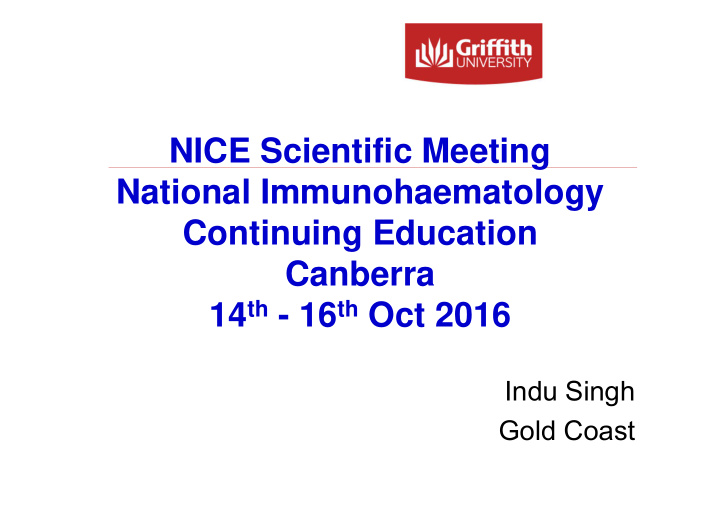



NICE Scientific Meeting National Immunohaematology Continuing Education Canberra 14 th - 16 th Oct 2016 Indu Singh Gold Coast
Where are we with making Platelets in-vitro for transfusion?
Why differentiate platelets in vitro ? Growing demand, limited availability, short shelf life, Lack of artificial platelet substitutes or in vitro – generated platelets 1 » Platelet production by MKs poorly understood & not yet reproduced for transfusion in vitro 2 Key regulators of platelet production » Cytokines, cell-cell & cell-matrix contacts + vascular shear stress New in vitro cultivation systems » Insights into the platelet formation » Basic studies on MK development & function Limitations » Combining these different parameters into one model » Inability to sufficiently control them to allow definitive conclusions
The microfluidic bioreactor design enables platelet production & its high-resolution real time visualization in vitro First microfluidic bioreactor design recapitulates central features of the bone marrow in vitro & enables high- yield platelet production with high- resolution real-time visualization of (Pro)platelet formation by megakaryocytes ex vivo 3 Proplatelet extension across the endothelial barrier (red) and subsequent release of (pre)platelets by megakaryocytes (green), as occurring in bone marrow sinusoids in vivo , has been very difficult to reproduce in vitro 4
The microfluidic device a) Large entrance compartment, distributes the MK suspension among 16 straight channels in serpentine shape on a single glass slide • The dark blue region form the pillar forests covering the straight part of the channels, while the U-turns are devoid of obstacles. b) Pillars are arranged on a tilted hexagonal lattice to ensure that each cell encounters at least one pillar. The streamlines are illustrated with black lines and MKs with orange spheres c) Top view of the micro pillar array before cell perfusion and after 60 minutes perfusion
How far have we reached……. Platelet BioGenesis is a pre-clinical stage biotech company that was spun out of Harvard in 2014 to produce donor-independent human platelets from pluripotent stem cells » Developed a microfluidic bioreactor to generate functional platelets from human stem cell cultures and HPS in BM at scale » Enables platelet production & its high-resolution real time visualization in vitro » Striking increase in platelet yields by a magnitude of 2 fold compared with static conditions High quality of instant platelet product, generated from murine fetal liver– and human-induced pluripotent stem cell–derived MKs, assessed by performing morphologic and functional studies Their platelet product reflected the cytoskeletal organization & functionality of human & mouse platelets. 3
Where to from here….. Improve quality of the product under in vivo condition » Substitute platelet-depleted mice with in vitro –generated platelets » Assess platelet lifetime & function in models of hemostasis, thrombosis & thromboinflammation The “bioreactor-on-a-chip” mimic key features of the MK bone marrow microenvironment 5 » Provides high yields of (apparently) functional platelets & allows high-resolution real-time visualization of the dynamic process of proplatelet formation in vitro
References 1. de Kort W, Janssen M, Kortbeek N, Jansen N, van der Wal J, van Dijk N. Platelet pool inventory management: theory meets practice. Transfusion. 2011;51(11):2295-2303. 2. Machlus KR, Thon JN, Italiano JE Jr. Interpreting the developmental dance of the megakaryocyte: a review of the cellular and molecular processes mediating platelet formation. Br J Haematol. 2014;165(2):227-236. 3. Thon JN, Mazutis L, Wu S, et al . Platelet bioreactoron-a-chip. Blood. 2014;124(12):1857-1867. 4. Simon Stritt, Bernhard Nieswandt. In vitro platelets in sight. Blood 2014 124:1849-1850 5. Nakagawa Y, Nakamura S, Nakajima M, et al. Two differential flows in a bioreactor promoted platelet generation from human pluripotent stem cell-derived megakaryocytes. Exp Hematol . 2013;41(8):742-748.
Recommend
More recommend